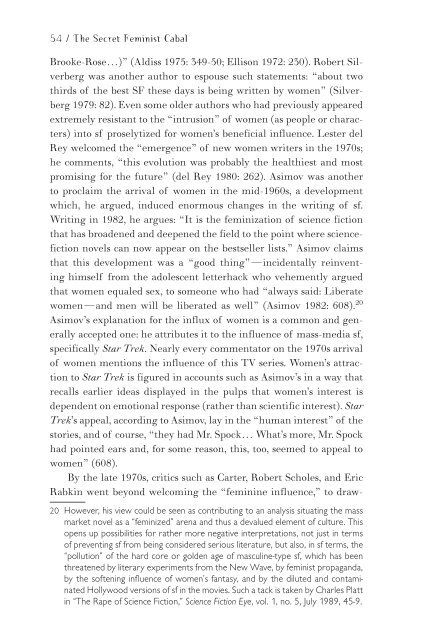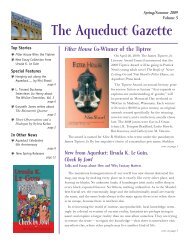Feminist Ca
Read Chapters Two and Three - Aqueduct Press
Read Chapters Two and Three - Aqueduct Press
- No tags were found...
You also want an ePaper? Increase the reach of your titles
YUMPU automatically turns print PDFs into web optimized ePapers that Google loves.
54 / The Secret <strong>Feminist</strong> <strong>Ca</strong>bal<br />
Brooke-Rose…)” (Aldiss 1975: 349-50; Ellison 1972: 230). Robert Silverberg<br />
was another author to espouse such statements: “about two<br />
thirds of the best SF these days is being written by women” (Silverberg<br />
1979: 82). Even some older authors who had previously appeared<br />
extremely resistant to the “intrusion” of women (as people or characters)<br />
into sf proselytized for women’s beneficial influence. Lester del<br />
Rey welcomed the “emergence” of new women writers in the 1970s;<br />
he comments, “this evolution was probably the healthiest and most<br />
promising for the future” (del Rey 1980: 262). Asimov was another<br />
to proclaim the arrival of women in the mid-1960s, a development<br />
which, he argued, induced enormous changes in the writing of sf.<br />
Writing in 1982, he argues: “It is the feminization of science fiction<br />
that has broadened and deepened the field to the point where sciencefiction<br />
novels can now appear on the bestseller lists.” Asimov claims<br />
that this development was a “good thing” — incidentally reinventing<br />
himself from the adolescent letterhack who vehemently argued<br />
that women equaled sex, to someone who had “always said: Liberate<br />
women — and men will be liberated as well” (Asimov 1982: 608). 20<br />
Asimov’s explanation for the influx of women is a common and generally<br />
accepted one: he attributes it to the influence of mass-media sf,<br />
specifically Star Trek. Nearly every commentator on the 1970s arrival<br />
of women mentions the influence of this TV series. Women’s attraction<br />
to Star Trek is figured in accounts such as Asimov’s in a way that<br />
recalls earlier ideas displayed in the pulps that women’s interest is<br />
dependent on emotional response (rather than scientific interest). Star<br />
Trek’s appeal, according to Asimov, lay in the “human interest” of the<br />
stories, and of course, “they had Mr. Spock… What’s more, Mr. Spock<br />
had pointed ears and, for some reason, this, too, seemed to appeal to<br />
women” (608).<br />
By the late 1970s, critics such as <strong>Ca</strong>rter, Robert Scholes, and Eric<br />
Rabkin went beyond welcoming the “feminine influence,” to draw-<br />
20 However, his view could be seen as contributing to an analysis situating the mass<br />
market novel as a “feminized” arena and thus a devalued element of culture. This<br />
opens up possibilities for rather more negative interpretations, not just in terms<br />
of preventing sf from being considered serious literature, but also, in sf terms, the<br />
“pollution” of the hard core or golden age of masculine-type sf, which has been<br />
threatened by literary experiments from the New Wave, by feminist propaganda,<br />
by the softening influence of women’s fantasy, and by the diluted and contaminated<br />
Hollywood versions of sf in the movies. Such a tack is taken by Charles Platt<br />
in “The Rape of Science Fiction,” Science Fiction Eye, vol. 1, no. 5, July 1989, 45-9.




